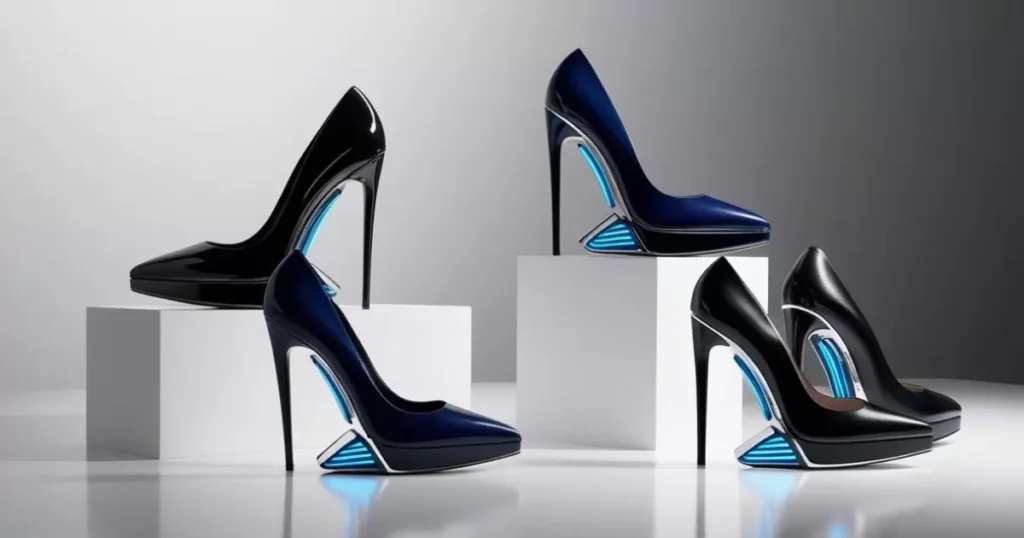Introduction
If you’re a high heel enthusiast, you’ve probably experienced the all-too-common problem of clomping and clicking your way through quiet environments. Whether you’re tip-toeing through the office, trying to sneak past sleeping roommates, or navigating marble-floored art galleries, the sound of your stilettos can be a source of embarrassment and distraction.
But fear not, fellow heel-wearers! There are a variety of techniques and solutions to help you silence those noisy shoes and reclaim your stealth. In this comprehensive guide, we’ll dive into the anatomy of high heels, explore the root causes of their distinctive sounds, and equip you with a toolbox of proven noise reduction strategies. By the end, you’ll be gliding through any setting with the grace and quiet elegance of a prima ballerina.
Understanding the Anatomy of High Heels
To effectively address the noise issues associated with high heels, it’s helpful to first understand the basic construction and features of these fashionable footwear. High heels come in a wide range of styles, heights, and materials, each with its own unique characteristics that contribute to the overall sound profile.
At the most fundamental level, high heels consist of three primary components:
- The Heel: This is the raised, vertical portion that supports the wearer’s weight and propels them forward. Heel types can vary greatly, from slender stilettos and chunky platforms to kitten heels and wedges. The height, shape, and material of the heel all play a role in how much noise it generates.
- The Sole: The sole is the flat, bottom part of the shoe that comes into direct contact with the ground. Soles can be made from a variety of materials, such as leather, rubber, or synthetic compounds, each with different levels of traction and sound-dampening properties.
- The Upper: This refers to the top part of the shoe that covers and secures the foot. Uppers can be crafted from leather, suede, fabric, or other materials, and their design and construction can also contribute to overall noise levels.
The interplay between these three components, as well as factors like the wearer’s stride, posture, and weight distribution, all contribute to the distinctive click, clack, and thud of high heels. Understanding these nuances is the first step toward developing effective strategies for quieter steps.
Common Noise Issues and Their Causes
Navigating various surfaces while wearing high heels can be a veritable symphony of sounds, from the resonant click-clack on hardwood floors to the muffled thud on carpets. Let’s take a closer look at the most common noise issues and the underlying factors that cause them.
Noise on Hard Surfaces
High heels tend to be the loudest on hard, smooth surfaces like marble, tile, and hardwood. The rigid heel and sole materials, combined with the concentrated force of each step, create a sharp, percussive sound that can reverberate through the environment. This effect is amplified in settings with high ceilings or sparse furnishings, where the sound waves have ample space to travel.
Noise on Soft Surfaces
While high heels may not make as much noise on soft, textured surfaces like carpets or rugs, they can still produce an audible thud with each stride. This is largely due to the weight of the wearer and the impact of the heel striking the surface. The softer the material, the more it will absorb and muffle the sound, but it won’t completely eliminate it.
Noise from Stride and Posture
The way you walk in high heels can also contribute to the overall noise level. A heavy-footed, heel-first stride will generate more sound than a light, balanced step. Similarly, poor posture and uneven weight distribution can cause the heel to strike the ground with more force, amplifying the noise. Mindful, controlled movements are key to minimizing the auditory impact of your high heels.
Noise from Heel Type and Material
The specific design and materials of the heel itself play a significant role in determining how much noise it makes. Slender, stiletto-style heels tend to be the loudest, as they concentrate the wearer’s weight on a small surface area. Chunkier heels, on the other hand, distribute the weight more evenly, resulting in a softer sound. The type of material used for the heel, such as metal, wood, or plastic, can also affect the tone and volume of the noise.
By understanding the factors that contribute to high heel noise, you can begin to explore effective solutions and techniques to help silence your steps.
Simple Noise Reduction Techniques
Fortunately, there are a number of simple, cost-effective solutions that can help dampen the sound of your high heels without compromising their style or comfort. Let’s take a look at some of the most popular and practical options:
Adhesive Sole Pads/Inserts
One of the easiest and most accessible ways to muffle high heel noise is by using adhesive sole pads or inserts. These small, cushioned discs or strips adhere to the bottom of your shoes, providing an extra layer of sound-dampening material between the heel and the ground. They’re typically made of rubber, silicone, or other soft, pliable compounds that absorb impact and reduce vibrations.
Adhesive sole pads come in a wide range of sizes and shapes to fit different heel styles, and they’re generally very affordable, making them a great DIY solution. They’re also easy to apply and can be removed without leaving any residue, making them a versatile option for both temporary and more long-term use.
Rubber or Silicone Heel Tips

Another simple noise-reducing technique is to replace your existing heel tips with specialized rubber or silicone versions. These aftermarket heel tips are designed to fit snugly over the existing heel, creating a softer, more cushioned surface that contacts the ground.
Rubber and silicone heel tips are available in a variety of sizes and shapes to accommodate different heel types, and they’re often easy to install and remove as needed. They tend to be more durable than adhesive sole pads, making them a good choice for regular use, and they can also help improve traction and prevent slipping on smooth surfaces.
DIY Heel Covers
For a more customized and stylish noise-reduction solution, you can create your own heel covers using materials like felt, fabric, or even leather. These DIY heel covers slide over the existing heel, providing a soft, muffling layer between the hard heel and the ground.
Felt and fabric heel covers are relatively simple to make, and you can choose colors and patterns that complement your shoe style. Leather heel covers require a bit more skill and attention to detail, but they can create a sleek, high-end look. Whichever material you choose, DIY heel covers offer a personalized way to silence your stilettos.
These simple, low-cost solutions can be extremely effective in dampening high heel noise, particularly on hard surfaces. However, for more advanced or long-term noise mitigation strategies, you may need to explore some additional options.
Advanced Noise Mitigation Strategies
While the simple solutions mentioned above can go a long way in quieting your high heels, there are also more involved, professional-grade techniques that can provide even greater noise reduction. Let’s dive into some of the more sophisticated approaches:
Anti-Slip/Sound-Dampening Coatings
For a more permanent and comprehensive noise-reduction solution, you can consider having your high heels treated with a specialized anti-slip or sound-dampening coating. These coatings are typically applied by a professional, and they create a protective layer on the heel and sole that helps absorb impact and minimize vibrations.
The coatings are often made from durable, high-performance materials like polyurethane or silicone, and they can be customized to match the color and texture of your shoes. In addition to reducing noise, these coatings can also improve traction and prevent slipping, making them a practical choice for both fashion and function.
While the initial investment for this treatment may be higher than some of the DIY options, the long-lasting benefits and the professional-grade finish can make it a worthwhile investment for those who wear high heels frequently.
Customized Heel Replacements or Modifications
For an even more tailored approach, you can explore the possibility of having your high heels modified or having the heels replaced entirely. This involves working with a shoemaker or cobbler to either replace the existing heel with a quieter, custom-made version or to make alterations to the existing heel to improve its noise-dampening properties.
Some potential modifications could include:
- Replacing the heel with a thicker, chunkier design
- Swapping out the heel material (e.g., from metal to wood or rubber)
- Adding shock-absorbing inserts or cushioning to the heel
- Reshaping the heel to distribute weight more evenly
This level of customization allows you to create a truly bespoke solution that addresses the specific noise issues of your high heels, while also potentially improving their comfort and stability.
Innovative Shock-Absorbing Heel Designs

In recent years, some shoe designers and manufacturers have been experimenting with innovative heel designs that incorporate advanced shock-absorbing technologies. These cutting-edge heels are engineered to minimize noise and vibration through the use of specialized materials and internal structures.
For example, some heels feature hollow, cellular-foam cores that compress upon impact to dissipate the force, while others incorporate resilient, rubberized elements that flex and absorb the shock of each step. These innovative designs not only help to reduce noise but can also improve overall comfort and support for the wearer.
While these specialized high heels may come with a higher price tag, they represent the pinnacle of noise-reduction technology in the world of stilettos and can be a worthwhile investment for those who prioritize both style and stealth.
By exploring these more advanced noise mitigation strategies, you can achieve even greater levels of silence and control over the sound of your high heels, making them a seamless and discreet part of your everyday wardrobe.
Walking Tips for Quieter Steps
In addition to the various noise-reduction solutions we’ve covered, the way you walk in your high heels can also have a significant impact on the overall sound they produce. By adopting some mindful, controlled walking techniques, you can further minimize the click and clack of your stilettos.
Posture and Heel Placement
Maintaining good posture and being mindful of how you place your heels on the ground can go a long way in reducing noise. Stand up straight, with your shoulders back and your weight evenly distributed on both feet. When taking a step, focus on placing the heel down first, then gradually rolling through to the ball of the foot, rather than slamming the heel down forcefully.
Mindful Striding Techniques
Avoid taking long, heavy strides that create a loud, percussive sound. Instead, aim for shorter, lighter steps, keeping your movements controlled and deliberate. This can help to dampen the impact of the heel striking the ground and create a more subtle, muffled sound.
Weight Distribution and Balance
Pay close attention to how you distribute your weight as you walk. Shifting your weight too far forward or backward can cause the heel to strike the ground with more force, amplifying the noise. Strive for a balanced, centered stance that keeps your weight evenly distributed across the entire foot.
By incorporating these walking techniques into your high heel routine, you can further enhance the effectiveness of the noise-reduction solutions we’ve discussed, creating a stealthy, elegant stride that is a pleasure to both see and hear.
Maintenance and Material Considerations
Maintaining the condition of your high heels and being mindful of the materials used in their construction can also play a role in keeping them as quiet as possible.
Heel Care and Preservation
Regularly inspecting and caring for the heels of your shoes is crucial for preserving their noise-dampening properties. Check for any signs of wear, such as cracks, splits, or uneven wear patterns, and address them promptly. Depending on the issue, you may be able to have the heels repaired or replaced by a professional cobbler.
Additionally, be sure to clean and condition the heels regularly to keep the materials supple and prevent premature deterioration. Avoid letting the heels become overly worn or damaged, as this can compromise their ability to absorb sound and impact.
Material Selection
When selecting high heels, pay close attention to the materials used in the heel, sole, and upper construction. As a general rule, softer, more pliable materials like rubber, silicone, and certain types of leather tend to be more effective at dampening noise than harder, more rigid materials like metal or synthetic plastics.
Additionally, consider the traction properties of the sole material. Shoes with higher-grip soles can help reduce the “slapping” sound that can occur on smooth surfaces, further contributing to a quieter stride.
By prioritizing heel maintenance and thoughtfully choosing high-quality, noise-dampening materials, you can extend the lifespan of your silent stilettos and ensure they remain a discreet and elegant part of your wardrobe.
Conclusion
Navigating the world in high heels doesn’t have to be a noisy affair. By understanding the anatomy of these fashionable footwear, identifying the common causes of high heel noise, and exploring a range of proven noise reduction techniques, you can reclaim your stealth and glide through any setting with grace and confidence.
Whether you opt for simple DIY solutions, invest in professional-grade treatments, or adopt mindful walking habits, the key is to experiment and find the strategies that work best for your individual needs and shoe preferences. With a little know-how and a touch of creativity, you can silence those stilettos and enjoy the style and confidence that comes with wearing high heels, no matter the environment.
So, the next time you find yourself in a quiet space, don’t let the click-clack of your heels give away your presence. Embrace the secrets to silencing your stilettos and let your style shine through in blissful silence.
Frequently Asked Questions
1. What are the main causes of high heel noise?
The primary causes of high heel noise include the hard, rigid materials used in the heel and sole construction, the concentrated force of each step on hard surfaces, and poor walking techniques like heavy-footed strides and uneven weight distribution.
2. What are some simple DIY solutions to quiet high heels?
Some easy DIY solutions include using adhesive sole pads/inserts, replacing the existing heel tips with rubber or silicone versions, and creating custom heel covers using materials like felt, fabric, or leather.
3. What are the pros and cons of professional anti-slip/sound-dampening coatings?
The main pros of professional coatings are their long-lasting noise reduction, improved traction, and sleek, customized appearance. The cons include the higher initial cost and the need for professional application. However, the benefits often outweigh the drawbacks for frequent high heel wearers.
4. How do innovative shock-absorbing heel designs help reduce noise?
Specialized heel designs that incorporate advanced shock-absorbing technologies, such as cellular foam cores or resilient rubber elements, can help dissipate the impact force and minimize vibrations, resulting in a quieter stride.
5. What are some best practices for walking in high heels to reduce noise?
Key walking techniques for quieter high heels include maintaining good posture, placing the heel down first and rolling through the step, taking shorter and lighter strides, and ensuring even weight distribution across the foot.

An author is a creator of written content, producing works ranging from books and articles to blog posts and essays. They use their creativity, knowledge, and research to inform, entertain, or persuade readers. Authors often have a unique voice and perspective, contributing significantly to literature and various media.

